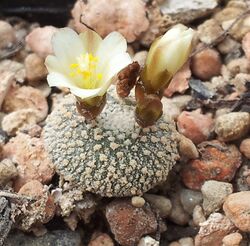Biology:Blossfeldia
| Blossfeldia | |
|---|---|

| |
| Scientific classification | |
| Kingdom: | Plantae |
| Clade: | Tracheophytes |
| Clade: | Angiosperms |
| Clade: | Eudicots |
| Order: | Caryophyllales |
| Family: | Cactaceae |
| Subfamily: | Cactoideae |
| Tribe: | Blossfeldieae Crozier |
| Genus: | Blossfeldia Werderm. |
| Species: | B. liliputana
|
| Binomial name | |
| Blossfeldia liliputana Werderm.[1]
| |
| Synonyms[1] | |
| |
Blossfeldia is a genus of cactus (family Cactaceae) containing only one species, Blossfeldia liliputana,[1] native to South America in northwestern Argentina [2] (Jujuy,[3] Salta, Tucumán, Catamarca and Mendoza Provinces)[4] and southern Bolivia[2] (Santa Cruz and Potosí Departments).[4] It grows at 1,200–3,500 m altitude in the Andes, typically growing in rock crevices,[2] and often close to waterfalls.[citation needed]
Description
It is of note as the smallest cactus species in the world, with a mature size of around 10–12 mm diameter, solitary or with many dark green stems forming colonies in the fissures of the rocks, it does not have ribs or tubercles, nor spines. The flowers are white or rarely pink, 6–15 mm long and 5–7 mm diameter.[2]
The genus Blossfeldia has been divided into many separate species; however most morphological evidence supports that the genus is monotypic, and contains only Blossfeldia liliputiana.[5] The flowers emerge from the apex of the stem, 0.5 to 1 cm long and 0.5 cm in diameter, white. They self-pollinate. The fruit is globose, red and woolly with very small brown seeds.
The species is named after the fictional country of Lilliput, where all of the inhabitants are minute.
Taxonomy
The genus and species were first described in 1937 by Erich Werdermann after being discovered in northern Argentina by Harry Blossfeld and Oreste Marsoner while exploring northern Argentina in 1936.[3] The genus name honors Blossfeld.[2] Blossfeldia liliputiana has several features making it unique among cacti, including a very small number of stomata, the absence of a thickened cuticle, and hairy seeds with an aril. It is placed in the subfamily Cactoideae, and traditionally in the tribe Notocacteae.[2] However, molecular phylogenetic studies have repeatedly shown that it is sister to the remaining members of the subfamily, and well removed from other genera placed in the Notocacteae:[6][7]
| subfamily Cactoideae |
| ||||||||||||
Recognizing the position of Blossfeldia, Nyffeler and Eggli, in their 2010 classification of Cactaceae, placed it in a separate tribe, Blossfeldieae, within Cactoideae.[8] Earlier, Blossfeldia was considered as a distinct genus within the tribe Notocacteae;[2] it had even been placed in an entirely separate subfamily, Blossfeldioideae.[9]
A nomenclature synonym is Parodia liliputana (Werderm.) N.P.Taylor (1987).
References
- ↑ 1.0 1.1 1.2 "Blossfeldia liliputana Werderm.". The Plant List. http://www.theplantlist.org/tpl1.1/record/kew-2677651. Retrieved 2017-04-01.
- ↑ 2.0 2.1 2.2 2.3 2.4 2.5 2.6 Anderson, Edward F. (2001). The Cactus Family. Pentland, Oregon: Timber Press. pp. 129–130. ISBN 978-0-88192-498-5.
- ↑ 3.0 3.1 Werdermann, Von E. (1937). "Aus den Sammelergebnissen der Reisen von H. Bloßfeld und O. Marsoner durch Südamerika III.". Kakteenkunde 11: 161–163. https://www.cactuspro.com/biblio_fichiers/pdf/Kakteenkunde/Kakteenkunde1937_O.pdf.
- ↑ 4.0 4.1 Leuenberger, Beat Ernst (2008). "Pereskia, Maihuenia, and Blossfeldia—Taxonomic History, Updates, and Notes". Haseltonia 14: 54–93. doi:10.2985/1070-0048-14.1.54.
- ↑ "Blossfeldia liliputana". http://llifle.com/Encyclopedia/CACTI/Family/Cactaceae/5701/Blossfeldia_liliputana.
- ↑ Bárcenas, Rolando T; Yesson, Chris; Hawkins, Julie A (2011). "Molecular systematics of the Cactaceae". Cladistics 27 (5): 470–489. doi:10.1111/j.1096-0031.2011.00350.x. PMID 34875796.
- ↑ Hernández-Hernández, Tania; Hernández, Héctor M.; De-Nova, J. Arturo; Puente, Raul; Eguiarte, Luis E.; Magallón, Susana (2011). "Phylogenetic relationships and evolution of growth form in Cactaceae (Caryophyllales, Eudicotyledoneae)". American Journal of Botany 98 (1): 44–61. doi:10.3732/ajb.1000129. PMID 21613084.
- ↑ Nyffeler, R.; Eggli, U. (2010). "A farewell to dated ideas and concepts: molecular phylogenetics and a revised suprageneric classification of the family Cactaceae". Schumannia 6: 109–149. doi:10.5167/uzh-43285.
- ↑ Crozier, B.S. (2004). "Subfamilies of Cactaceae Juss., including Blossfeldioideae subfam. nov.". Phytologia 86: 52–64. http://direct.biostor.org/reference/131754. Retrieved 2017-04-01.
Bibliography
- Buxbaum F., "Gattung Blossfeldia", in Krainz H., Die Kakteen, 1.11.1964
- Fechser H., "Blossfeldia liliputana - The Tiniest Cactus", Cact. Succ. J. (US), 32 : 123-125, 1960
- John V., "Strombocactus, Blossfeldia a Aztekium", Kaktusy, 23 : 38-41, 1987
- Kilian G., "Beitrag zur Blossfeldia-Kultur", Kakt. und and. Succ., 13 : 82-83, 1962
- Köhler U., "Beobachtungen an Blossfeldien", Kakt. und and. Succ., 17 : 11-14, 1966;
- "Blossfeldia heute", Kakt. und and. Sukk., 32 : 132133, 1981
- Říha J., "Blossfeldia liliputana Werdermann, Kaktusy, 22 : 105-107, 1986
- E. Werdermann (1937). "Neue und kritische Kakteen aus den Sammelergebnissen der Reisen von Harry Bloßfeld und O. Marsoner durch Südamerika 1936/37, III". Kakteenkunde: 161–164. http://www.cactuspro.com/biblio_fichiers/pdf/Kakteenkunde/Kakteenkunde1937.pdf. Retrieved 30 July 2014.
- {{citation
| mode = cs1 | title = Blossfeldia liliputana | work = Germplasm Resources Information Network (GRIN) | url = https://npgsweb.ars-grin.gov/gringlobal/taxonomydetail.aspx?451100 | publisher = [[Organization:Agricultural Research ServAgricultural Research Service (ARS), United States Department of Agriculture (USDA) | access-date = }}
External links
- Mauseth cacti research: Blossfeldia liliputana
- Cacti Guide: Blossfeldia liliputana
- Blossfeldia liliputana habitat pictures
Wikidata ☰ {{{from}}} entry
 |




